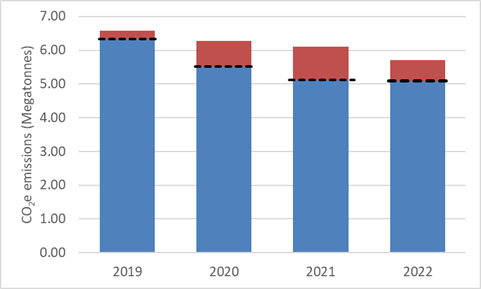Nova Scotia and its price on emissions
Larry Hughes, PhD
24 March 2023
A year ago, the province was arguing that its carbon pricing system should be kept because it was less costly to Nova Scotians than the federal carbon system.
Now we know why.
Between 2019 and 2022, Nova Scotians did not pay for the greenhouse gas emissions that exceeded Nova Scotia Power's emissions cap.
Minister Halman stated that this amounted to about 2.6 million tonnes of emissions.
The minister went on to say that if Nova Scotians are required to pay for these emissions, it will cost them about $165 million dollars. This is equivalent to about 1.6 cents per kilowatt-hour.
It did not need to be this way.
Nova Scotia Power's annual emissions limit (or cap) was set by the province as part of its cap-and-trade system.
Emissions below the cap were exempt from the price on carbon. Emissions above the cap could be traded with other large emitters in the province. All emissions were to have been subject to the federal price on carbon emissions for that year.
The following chart shows Nova Scotia Power's annual emissions and its annual emissions cap for 2019 through 2022. The blue bars are the annual emissions below the cap, while the red are the emissions above the cap. The dashed line indicates the cap. The 2022 emissions above the cap are an estimate.

Figure 1: Nova Scotia Power's emissions and its emission limits between 2019 and 2022
Nova Scotia's cap-and-trade market was very small and dominated by one large emitter, Nova Scotia Power. With the prospect of Muskrat Falls coming on-line in 2020, it appears to have been assumed that Nova Scotia Power would soon be below its cap and the cap-and-trade system would work as intended.
In response to the delays to Muskrat Falls, not only did the then provincial government change the rules on Nova Scotia Power's renewable regulations, they also relaxed the rules regarding Nova Scotia Power's emissions cap.
If Nova Scotians had been required to pay for the excess emissions when they occurred, the costs would have ranged from about 0.05 cents per kilowatt-hour in 2019 (at $20 per tonne) to 0.38 cents per kilowatt-hour in 2021 (at $40 per tonne).
The decision to shield Nova Scotians from paying for these emissions was well-meaning but short-sighted.
Rather than hoping that Muskrat Falls would eventually work, the provincial government could have developed a rebate program for low-income Nova Scotians to offset the costs of paying for electricity emissions. Any excess revenues could have been channeled into energy efficiency programs.
Instead, the unpaid-for emissions were allowed to accumulate. As a result, Nova Scotians could be required to pay for these emissions. If this happens, it could be more costly than had the emissions been paid for when they occurred.
Last year's objections to the federal price on carbon by the province overlooked the facts that at least the federal price is designed so that we know what we will pay, when we will pay it, and when to expect the carbon rebate.
Published: allnovascotia.com 23 March 2023